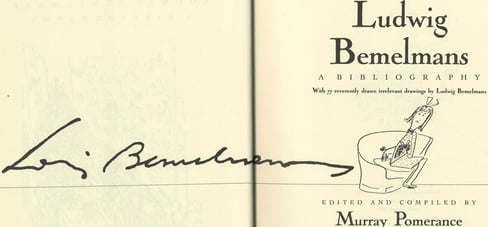For many small children outside of Europe, their first ideas of Paris come from a children's book, and for them, the heart of the city is a vine-covered old house full of little girls in yellow dresses, the smallest and most important being Madeline. The man behind the first seven Madeline books (the series has since been picked up by his grandson) was Ludwig Bemelmans. Though he published over forty-six books in his lifetime and posthumously, it is for Madeline that he is most fondly remembered.
 Bemelmans was born in 1898 in Meran, Austria, now Merano, Italy. His father was a painter and a hotelier, two occupations Bemelmans himself pursued at different times of his life. The family lived in Austria until his father left them for their governess, at which point his mother moved him and his brother to her native Germany. Despising the German system of education, Bemelmans eventually returned to Austria to apprentice under his uncle who worked at a hotel. His apprenticeship was short, however, as he had to emigrate to the United States after shooting and injuring a waiter employed at the hotel. He continued to work in the service industry in the United States until he enlisted in the Army in 1917 to participate in World War I. Because of concerns over his German ancestry, he was never deployed to the frontlines in Europe, though he did become a Second Lieutenant.
Bemelmans was born in 1898 in Meran, Austria, now Merano, Italy. His father was a painter and a hotelier, two occupations Bemelmans himself pursued at different times of his life. The family lived in Austria until his father left them for their governess, at which point his mother moved him and his brother to her native Germany. Despising the German system of education, Bemelmans eventually returned to Austria to apprentice under his uncle who worked at a hotel. His apprenticeship was short, however, as he had to emigrate to the United States after shooting and injuring a waiter employed at the hotel. He continued to work in the service industry in the United States until he enlisted in the Army in 1917 to participate in World War I. Because of concerns over his German ancestry, he was never deployed to the frontlines in Europe, though he did become a Second Lieutenant.
At the end of his Army service, he returned to hotel work, though he also attempted at this time to pursue more creative endeavors. His comic The Thrilling Adventures of the Count Bric a Brac was picked up by New York World but was canceled after only six months of publication. He published his first book, Hansi, in 1934, but his second book was rejected before finding a home with Simon & Schuster in 1939. This second book launched his much beloved series, Madeline.
Madeline was named a Caldecott Honor book in 1940 and its first sequel, Madeline's Rescue followed in 1953 and won the Caldecott Medal. Bemelmans went on to publish four more Madeline books in his lifetime, the fourth, Madeline's Christmas appearing in McCall's magazine as a special insert (though it was later published as a book in 1985). The final Madeline book written by Bemelmans, Madeline in America and Other Holiday Tales, was discovered and published in 1999, thirty-seven years his death.
 Though Bemelmans wrote only seven Madeline picture books, she is considered one of the greatest characters of children's literature alongside other literary icons like Eloise, Winnie-the-Pooh, and the Pevensie children. Fortunately for children today and their parents who grew up reading Madeline, her story has continued. Since 2008, Bemelmans' grandson, John Bemelmans Marciano—himself a writer and painter—has written and illustrated new Madeline stories, including Madeline and the Cats of Rome, Madeline and the Old House in Paris, Madeline says Merci, and Madeline at the White House.
Though Bemelmans wrote only seven Madeline picture books, she is considered one of the greatest characters of children's literature alongside other literary icons like Eloise, Winnie-the-Pooh, and the Pevensie children. Fortunately for children today and their parents who grew up reading Madeline, her story has continued. Since 2008, Bemelmans' grandson, John Bemelmans Marciano—himself a writer and painter—has written and illustrated new Madeline stories, including Madeline and the Cats of Rome, Madeline and the Old House in Paris, Madeline says Merci, and Madeline at the White House.
Madeline has become an important franchise. Beyond just her picture books, there exists now a book of paper dolls, a series of books for slightly older readers, animated television shows and films (the first 1952 adaptation was nominated for an Academy Award), toys and dolls, a 1998 live-action movie, and even educational video games. All of this ensures that Bemelman's legacy lives on for further generations of children to be inspired by Madeline's brave and curious character.









